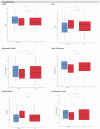Myocardial Performance Improvement After Iron Replacement in Heart Failure Patients: The IRON-PATH II Echo-Substudy
- PMID: 40565791
- PMCID: PMC12193777
- DOI: 10.3390/jcm14124048
Myocardial Performance Improvement After Iron Replacement in Heart Failure Patients: The IRON-PATH II Echo-Substudy
Abstract
Background: Iron deficiency (ID) is a commonly seen comorbidity in heart failure (HF) patients. It is often associated with a poor prognosis and impaired physical capacity. The functional limitations linked to ID may lead to cardiac function abnormalities. The functional limitations linked to ID may lead to cardiac function abnormalities, that can be reversible after iron repletion. Some echocardiographic parameters, such as global longitudinal strain (GLS), myocardial work (MW) and its derivatives constructive work (CW), wasted work (WW) and work efficiency (WE), may be of added value in advanced cardiac performance assessment. Methods: IRON-PATH II was a multicenter, prospective and observational study designed to describe the pathophysiological pathways associated with ID. The echo-substudy included 100 HF patients that had undergone a specific pilot echocardiographic evaluation. Patients had a left ventricular ejection fraction (LVEF) ≤50%, were in stable clinical condition and on standard HF medication with hemoglobin ≥11 g/dL. The final cohort included 98 patients. Results: The ID group showed worse cardiac function, with lower GLS (-8.5 ± 9% vs. -10 ± 10%), WE (74 ± 10% vs. 80 ± 10%) and MW (665 [453-1013] vs. 947 [542-1199] mmHg%), as well as higher WW (290 [228-384] vs. 212 [138-305] mmHg%) and lower RV free wall strain (-13 [-20-(-11)]% vs. -17 [-23-(-14)]%). Following iron repletion, ID patients demonstrated improved LV (GLS, MW, WE and WW) and RV performance (RV free wall strain), aligning with non-ID patients (all p-values >0.05 compared to the non-ID group). Conclusions: Among HF patients with reduced LVEF, ID was associated with worse myocardial performance in both the LV and RV. All the alterations seen were reversible after intravenous iron repletion.
Keywords: chronic heart failure; comorbidities; echocardiography; iron deficiency; myocardial work.
Conflict of interest statement
The authors declare that they have no conflicts of interest relevant to the contents of this manuscript. Silvia Jovells-Vaqué was hired with a PERIS grant. Please note that the present research did not receive any funding from a PERIS grant.
Figures


Similar articles
-
Effect of Iron Deficiency on Right Ventricular Strain in Patients Diagnosed with Acute Heart Failure.J Clin Med. 2025 Jul 22;14(15):5188. doi: 10.3390/jcm14155188. J Clin Med. 2025. PMID: 40806810 Free PMC article.
-
Markers of Iron Metabolism and Outcomes in Patients with Heart Failure: A Systematic Review.Int J Mol Sci. 2023 Mar 15;24(6):5645. doi: 10.3390/ijms24065645. Int J Mol Sci. 2023. PMID: 36982717 Free PMC article.
-
Changes in Cardiac Function and Exercise Capacity Following Ferric Carboxymaltose Administration in HFrEF Patients with Iron Deficiency.Diagnostics (Basel). 2025 Aug 2;15(15):1941. doi: 10.3390/diagnostics15151941. Diagnostics (Basel). 2025. PMID: 40804905 Free PMC article.
-
Effects of a gluten-reduced or gluten-free diet for the primary prevention of cardiovascular disease.Cochrane Database Syst Rev. 2022 Feb 24;2(2):CD013556. doi: 10.1002/14651858.CD013556.pub2. Cochrane Database Syst Rev. 2022. PMID: 35199850 Free PMC article.
-
Beta-blockers in patients without heart failure after myocardial infarction.Cochrane Database Syst Rev. 2021 Nov 5;11(11):CD012565. doi: 10.1002/14651858.CD012565.pub2. Cochrane Database Syst Rev. 2021. PMID: 34739733 Free PMC article.
References
-
- Melenovsky V., Petrak J., Mracek T., Benes J., Borlaug B.A., Nusková H., Pluhacek T., Spatenka J., Kovalcikova J., Drahota Z., et al. Myocardial iron content and mitochondrial function in human heart failure: A direct tissue analysis. Eur. J. Heart Fail. 2017;19:522–530. doi: 10.1002/ejhf.640. - DOI - PubMed
-
- Hoes M.F., Grote Beverborg N., Kijlstra J.D., Kuipers J., Swinkels D.W., Giepmans B.N.G., Rodenburg R.J., Van Veldhuisen D.J., De Boer R.A., Van Der Meer P. Iron deficiency impairs contractility of human cardiomyocytes through decreased mitochondrial function. Eur. J. Heart Fail. 2018;20:910–919. doi: 10.1002/ejhf.1154. - DOI - PMC - PubMed
-
- Zhang H., Jamieson K.L., Grenier J., Nikhanj A., Tang Z., Wang F., Wang S., Seidman J.G., Seidman C.E., Thompson R., et al. Myocardial Iron Deficiency and Mitochondrial Dysfunction in Advanced Heart Failure in Humans. J. Am. Heart Assoc. 2022;11:e022853. doi: 10.1161/JAHA.121.022853. - DOI - PMC - PubMed
Grants and funding
LinkOut - more resources
Full Text Sources
Research Materials
Miscellaneous

